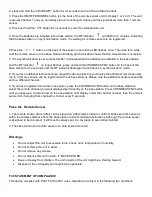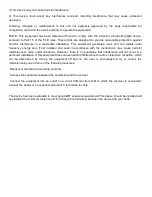
TX:
Press to send temperature/humidity data to the receiver manually.
Synchronize Remote Sensors with The Base Station
Please note: each time the batteries (either base station or remote sensor) are replaced or base
station/remote sensor lost connection, make sure to follow the below synchronization process to pair
and re-connect the base station and remote senor:
1. Position the remote sensor near the base station;
2. The RF signal icon
(located on the upper left of the base station display) will flash for 3 minutes,
indicating that the base station is in synchronization mode: it is waiting for remote sensors to be registered.
3. If 3 minutes have passed after the batteries were installed in the base station and the RF signal Icon
is
no longer flashing, press and hold the CHANNEL/SYNC button on the back of the base station for 3-4 seconds
until the RF signal icon is flashing again to set it back in synchronization mode;
4. Wait for a moment or just press either the TX or RESET button inside the remote sensor battery
compartment, the remote sensor temperature/humidity will show on the base station display which indicates
the synchronization is complete.
5. If you have additional remote sensors, repeat the above steps to register the remote sensors (up to 3 remote
sensors can be registered with one base station);
6. If you have registered more than one sensor, press the CHANNEL/SYNC button on the base station to
select the remote channel you want displayed permanently on the base station. Press CHANNEL/SYNC button
until you observe a circular arrow on the base station LCD display under the channel number. The unit will then
auto-scroll, changing from channel to channel every 5 seconds.
Place the Base Station and Remote Sensor
1. The indoor base station (receiver) should always be placed in a well ventilated indoor area and located
away from vents, heating or cooling elements, direct sunlight, windows, doors, or any other openings.
2. The remote sensor (transmitter) can be placed on a flat surface indoor or outdoor. Make sure the sensor is
within the transmission distance from the base station and with minimal obstructions.
3.
Although the remote sensor is designed to be rain-proof, the remote sensor must be always placed
upwards so that rain won’t get inside the sensor through the vent holes on the bottom of the senor
which functions to let the remote sensor detect the environmental temperature and humidity more
precisely and quickly.
4. The base station and remote sensor can both be wall mounted.
Synchronize
Remote
Sensors
with
The
Base
Station
ThermoPro
TX-4B
Universal
Waterproof
Transmitter
Monitor
Temperature
and
Humidity
Outdoor
Sensor
,
Compatible
with
TP63B/TP67B/TP68B/TP65B
Series
Indoor
Outdoor
Thermometer
1.
Place
the
remote
sensor
near
the
base
station;






















